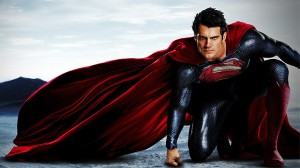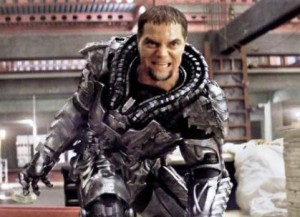Film Review: “Man of Steel” — Balancing Nostalgia and Techno-Lust
While the nostalgic exposition pays dutiful homage to the original story, the gangbuster finish should satisfy the audience’s summer techno-lust.
By Tim Jackson
Man of Steel has integrity, good performances, and mega-action, but be advised, it feels like two movies. At two and a half hours, there is plenty of time for each. The first part traces Kal-El’s origins from his birth and send off, Moses-like, from the dying planet of Krypton by his father Jor-El. Played with serious intention by a convincingly stoic Russell Crowe, Jor-El invokes the wrath of General Zod, usurper of the throne of Krypton. He will spend decades searching for the cast-off son and sole bearer of Krypton’s remaining DNA. He is an arch-villain bent on wiping out both Kal-el and all the inhabitants of Earth. But before this high stakes cosmic conflict begins, there is a gentler movie.
Appropriately, the film begins with the birth of Kal-El. The Krypton segments feature some fresh and dazzling effects that put the design of the film firmly in sci-fi territory. When we get to Earth and to the boy now known as Clark Kent, the film is shot in muted colors and sepia tones in an effort to evoke the warm glow of Kansas fields and domestic life. It is amid this Terrence Malick-like scenario that Clark comes of age and learns to cope with his curious powers. Ma and Pa Kent are nicely played by Diane Lane and real live Midwesterner, Kevin Costner, who teaches young Clark lessons in humility, patience, and what having his divine powers might mean: will he someday be the earth’s savior?
As part of his training, Clark even reads Plato, whose the Allegory of the Cave is a prophetic guide to the fact that perfection, goodness, and a Messianic mission may not be well received by earthlings. The story at this point has the charm of the old Superboy comics, a time when, without the aid of a video game, boys leapt about in homemade capes, vanquished imaginary evildoers and quelled childhood insecurities, and pictured themselves leaping over tall buildings in a single bound. A new word also entered childish vocabularies—“invulnerable.” The film’s allusions nod cautiously to Superman’s roots in quasi-religious myth. Pop culture studies abound with complex speculations about the significance of his origins with Jewish writer Jerry Siegel and artist Joe Shuster, his being casting off from a dying homeland, the hints of Hebrew in Kal-El and Jor-El, a father giving his only son to the world, and on and on.
But this is summer, and Plato is melting in the sun’s heat aided by gargantuan box office expectations. With a heaping helping of gonzo, futuristic techo-gadgetry and an apocalyptic scenario, Man of Steel’s second part gives action-hungry audience what they want. Earth is invaded by the troops of megalomaniac super-enemy General Zod, who is determined destroy Superman. His mission is to find Kal-El’s genetic code (to simplify a much more complicated plot point) and to scourge earth in an effort to spawn a new world.
The movie piles on every recent CG effect picturing urban destruction to create a super-battle between indestructible foes that will nearly destroy Metropolis and parts of Kansas. Michael Shannon brings capable menace to Zod, a role originally and wonderfully played by Terence Stamp. Though I prefer Shannon as Richard Kuklinsky, the murdering sociopath with a heart of stone in Iceman (released earlier this season), he is always an interesting actor to watch, given his bug-eyed mask of gravitas. Donning massive suits of armor and supported by an artillery of clamorous weaponry, he clobbers the Man of Steel, sending him through tall buildings with a single punch. Sometimes I even understood what he was talking about.
Henry Cavill is an appropriate hunk for the risky title role, moderating it with doses of subtlety and seriousness. By risky, I mean this iconic role can easily descend into innocuousness or parody, but Cavill handles the task of being earnestly impregnable well. (The other sense of “risky” is the “Superman Curse” where, like playing Jesus in film, the role had a reputation of leading to bad luck—previous Men of Steel George Reeves and Christopher Reeve suffered misfortune.)
Other details of the “myth” have been revised or reinvented for the new franchise. The “S” no longer really stands for “Superman,” but is apparently a symbol in Kryptonese for “Hope.” Lois Lane has a new relationship with the hero, one that tests her ethics as a reporter. As played by Amy Adams, Lois is as intrepid as she was on TV with Noel Neill, who at 93 currently lives in Metropolis, Illinois, where she reigns as the “First Lady of Metropolis.” There is a statue of Lois Lane in the town. Adams is also as feisty as Margot Kidder was in Superman I, II, III, and IV. Editor-in-chief of the Daily Planet, Perry White, is now black and no longer spouts, “Great Caesar’s Ghost,” but, as portrayed by Lawrence Fishburne, he maintains the character’s traditional blustery pessimism towards Lois and her “scoops.”
Jimmy Olsen is now Jenny Olsen. That isn’t a plot point; there’s no sex-change sub-plot. Apparently, the series needs two damsels to put in distress. Frankly, I miss the Jack Larsen-style “aw, shucks” cub reporter shtick. (Larsen, who played Jimmy on TV in the 50’s, became an accomplished librettist.)
Interestingly, Superman has lost his trunks. As explained by director Zak Snyder, the red shorts are “a leftover from the time of Victorian strongmen, the basis for the original design of the Superman costume in 1938. I feel like we’ve moved on a little bit from that era of modesty.” Amusingly, the name “Superman” is rarely uttered, and the world’s military has yet to come to terms with this avatar of peace, justice, and the American way. This hostility is entirely understandable considering the profuse amounts of destruction leveled upon the city. From Hellboy to Spiderman, the mayhem is always bloodless, of the video game variety, a showpiece of CG mastery. Thus while the nostalgic exposition pays dutiful homage to the humanity of the original story, the gangbuster finish should satisfy the audience’s summer techno-lust.
It is surprising that Hollywood tries to have it both ways? In his wonderful book Superman: The High Flying History of America’s Most Enduring Hero, Larry Tye quotes scriptwriter Edward Langley recalling a statement by an older writer about how to create suspense given Superman’s godlike powers: “The one thing Superman can’t do is strike a match on a cake of soap!” In Man of Steel, we get the soft soap and the flame.
Tim Jackson is an assistant professor at the New England Institute of Art in the Digital Film and Video Department. His music career in Boston began in the 1970s and includes some 20 groups, many recordings, national and international tours, and contributions to film soundtracks. He studied theater and English as an undergraduate and has also has worked helter skelter as an actor and member of SAG and AFTRA since the 1980s. He has directed two documentaries: Chaos and Order: Making American Theater about the American Repertory Theater, and Radical Jesters, which profiles the practices of 11 interventionist artists and agit-prop performance groups. His a third documentary, When Things Go Wrong, about the Boston singer/songwriter Robin Lane, with whom he has worked for 30 year, screens with a Q&A and live performances at the Regent Theater in Arlington on April 4th. You can read more of his work on his blog.




Actually, he lost his red trunks because they were dropped from the comic books about two years ago when D.C. comics chose to reimagine/reboot/revise all the characters. Consequently, outside of reprints likely had little input in the decision.
I think Snyder wasn’t taking credit, but merely explaining what he understood or heard as the rationale. I like the Victorian strongmen reference regardless, but no doubt the diapers had to go sometime.